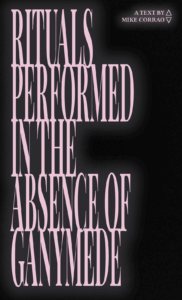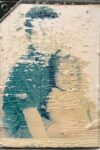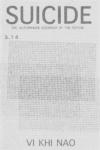
[11:11 Press; 2021]
Rituals Performed in the Absence of Ganymede is not easily described, at least not in such a way that might encapsulate the text and explain its meaning. So I will begin with some observations. The book is relatively slim, is completely unpaginated, and the text is presented in fragments. These fragments are often very short. There are some longer sections too. They extend down the page but never cross over to the next side. Occasionally text is redacted. There are also graphic incursions, and textual experiments, where text and architecture work together across the page and sometimes into the centrefold. The content of the book is closely related to the form of its presentation, although the content also strays beyond that form into the void it describes, and the body parts it repeatedly takes apart and re-assembles.
At just over 4 x 7 inches, Rituals Performed in the Absence of Ganymede fits easily into a coat pocket. Rituals is the kind of book to grab hold of as you leave the house, to travel and think with.
When Rituals landed, I placed it over my Vintage edition of The Gay Science. The edges matched up pretty well. The Cambridge edition, by contrast (like the rest of their collection of Nietzsche’s works), is not that kind of book. That version of The Gay Science is unbearably big and plain — I cannot stand it. The Gay Science benefits from a bit of fresh air, it needs to be the right kind of size.
What connects Rituals to Nietzsche, is the link that Mike Corrao maintains between body and text:
“The prose crawls from every pore . . . the text reveals its flesh.”
For Corrao, as for Nietzsche, body and text are inextricable.
As Corrao writes in the book’s opening:
“I shift from limb to text.
The dysmorphic assemblage forms my words, moves my tongue along delineated grooves.”
This dysmorphic assemblage is a body, or a thing that sometimes resembles what we think of as a body. It will not stay put, there is no knowing it, no seeing it, not really. But its effects can be felt by the words it emits and the words it suffers. Body dysmorphia is inevitable as this body, or this thing that resembles a body, stalks through Rituals, tearing apart, reassembling.
Although the body can never be truly known, its existence remains palpable. Every attempt to know it, distorts it, and each distortion can be heard as limbs creak, or fall away, within the text. The body breaks and crawls apart before inspection. This body, this thing, produces words, it forms them from its tongues, or anuses, along delineated grooves. These words then form the body in return. The body remains connected to its textual environment. Text cannot escape embodiment, and the body cannot escape its text.
The body and the text of Rituals are unstable. The text departs from the page throughout the book and mixes with its geometric, incantatory shapes. Both body and text are unreliable, and both are at work on one another.
§
Rituals has the kind of title that also works as a problem to wander with, to ponder over. What does it mean to perform a ritual in the absence of Ganymede? What is this Ganymede, what could it signify?
According to Homer, Ganymede was “the loveliest born of the race of mortals.” So lovely, indeed, that the Gods abducted Ganymede and had him live among them to fetch drinks and so on.
It would take a classical scholar to speculate over the significance of this abduction. But in present-day terms (the terms of Corrao’s book object), the absence of Ganymede might be understood differently, that is to say, anachronistically, as an abduction that took place only yesterday.
One reading is to understand the theft as a divine proclamation — this one is the loveliest — and an irredeemable loss — and so we take him from you. The Gods have no intention of giving him back. This leaves all other men with the spectacle of their relative ugliness. When one is selected as supreme, all others will be hideous, or at least inferior by degrees.
In our period the Gods are gone now too, and so Ganymede might be considered doubly absent. Ganymede is no longer on earth, and no longer with the immortals. There is no good example of a perfect body on earth — all men of earth are ugly — and there is no perfect body with the Gods that men can desire.
Rituals could be read as an account of this double absence. It charts the true and necessary devastation that occurs with the loss of Ganymede. Bodies are completely disoriented in this book. They will not be held together by an organizing idea, an idea that would identify its neighbor as a body too, and train that body to think of itself as an isolated entity with stable characteristics that it can work to improve, characteristics that are worth training for because improvement has meaning. All of that is absent in Rituals, producing the multiplicity of form and perception which that absence enables.
This book might also be read as an intervention in our current political moment, with so many attempts now to affirm other bodies and divergent psychologies, attempts that may seek to explode the body ideal, the normative body, but in doing so, only break that ideal into highly charged pieces. Each piece becomes its own universe of (counter-)ideals. Ganymede is still present in that broken but still active form.
Rituals, by contrast, offers a more radical disturbance of the body ideal. The complete absence of Ganymede makes any kind of body politics impossible. These bodies are abandoned to themselves, and, with nothing to hold them in place, they drift between themselves.
But Ganymede is also a moon, a satellite of Jupiter, the largest moon and the ninth-largest object in the solar system. This moon also happens to contain a huge amount of water, and so presents a likely target for space exploration — a refuelling, and resupply point at the very least. The absence of Ganymede might signify something different now, but still relatable.
If astronomers woke up one morning, and, looking for Ganymede found nothing there but the adjusted orbits of its neighbors, well that would unsettle a good few people. But most satisfying of all, this would constitute a severe blow to those who now look to space, seeking to expand their earthly empires to the exploitation of other zones. The absence of Ganymede would suggest that nothing out there can be depended upon to still be in orbit when these nasty, rapacious little men send their rockets into space.
Their crude scientism would be undermined. With nowhere to go, such men might begin to look down at their bodies and realize there is no escape from the flesh, not for them. They may hope to conquer space, they will flail the flesh of others, perhaps even develop technologies to augment themselves a little, but the body of each billionaire is deteriorating and will become its own soup or ash.
So the absence of Ganymede could signify the final absence of the body ideal, and the absence of a dependable universe — not even physics does what it should.
§
What could it mean to perform rituals in that absence, in the absence of Ganymede? Are these rituals just cultural echoes? Are they cultural artefacts that are on the brink of dying out? Are these the forlorn echoes of dying ideals and impulses as they were once acted out — Greek patriarchy finally destroyed; industrial man at last obliterated? Perhaps not, or not only.
“The body of the subject,” is indeed described as “An arcane machine made under precise ritual and procedure.” But the new bodies that appear in Rituals — these assemblages of organs and eviscerated innards — are made by ritual too. So I suspect that Corrao has other rituals in mind, not merely rituals that reinforce old norms, or that note their passing.
The obvious theoretical reference point for Rituals is the work of Deleuze and Guattari (although only Guattari is named in the text). As Corrao writes: “The subject is not a tree,” it is “rhizomatic.”
I was also reminded of Artaud, pounding his block of wood, perfecting his abysmal language and ritualistic practice. And yet, Artaud was inventing a new language, whereas Corrao remains largely within his own.
But Rituals made me turn to The Birth of Tragedy, in which Nietzsche places ritual back in the work of art, and art in the service of life. Ritualistic art offers a way of encountering chaos, a way of confronting the vast indifference of a universe where human suffering has no meaning. The point (for Nietzsche) is to survive that encounter without falling back on old securities, moral orders, stories, that make sense of the universe, that make its terrors bearable, by placing life in the service of a lie.
The challenge of placing ritual back in the work of art might be understood as an ongoing and endless task. In part, this is because art deteriorates, and reaches a point where it is simply enjoyed. As Nietzsche writes in The Gay Science, what good are
our works of art, if we lose that higher art, the art of festivals? Now one uses works of art to lure aside from the great via dolorosa [road of suffering] of humanity those who are wretched, exhausted, and sick . . .
The function of art in its reduced form is to offer brief moments of satisfaction, a little intoxication, a little madness to distract the wretched, exhausted, and sick — a list of suffering humanity that pretty much encapsulates all modern, civilized beings, from Nietzsche’s perspective.
If this reading can be justified, if it makes sense to read Rituals from this direction, what Corrao presents by returning ritual to art is a disturbance in the consumption of art (in this case the consumption of literature). This disturbance is also, at the same time, a disturbance in the fabric of text and body, a disturbance that eviscerates sense, and blocks consolation. Rituals conjures a state of suspension, where chaos is encountered and endured, where ritual prompts new acts of creation. Rituals submits the reader to a repeated genesis, but from scraps and leftovers, repurposed, re-assembled, to arrive at forms that are truly unknowable to their former selves.
§
I will finish this review by offering a brief overview of the characteristics of ritual, in Rituals, as I understood it:
1.
When rituals are referred to in the book, they are not easily performed, as if they do not come naturally. These ritualistic practices are not habitual, nor are they merely a set of cultural, or cultic residues.
As Corrao writes: “Someone attempts to perform my ritual but they get all of the words wrong.”
I suspect that the words themselves are unreliable (see #7).
2.
These rituals also remain unspecified. Corrao rarely uses the word, and he does not locate a particular ritual, or set of rituals, that might become the focus of the book. This is because ritual itself is changing, shifting in form, alongside its effects. Corrao writes at one point: “I will follow the procedures of a new ritual.” This applies throughout the book.
3.
Rituals question what is given: “you have found yourself adjusting the definitions of older words. Reinterpreting what can be called necessary or essential.”
4.
Corrao’s rituals are not just questioning, enquiring. They do not take apart body and text by study, by anatomizing it. They involve some kind of encounter with chaos, an encounter that must disturb the body, if not destroy it, so that it can re-assemble in other forms.
5.
When what is given is disturbed, what is left over can be reused: “What remains is, for the most part, a façade. Large flat plates, loose belts and cogs. Every reservoir and screw taken to repair more fruitful mechanisms. You collect each metal face and sew it to your exoskeleton.”
6.
Rituals are connected to one another as the remains of one ritual become the raw materials for the next. Something strays between one assemblage, one vessel, and another. This entity passes through the book.
7.
Rituals involve objects and employ bodies and body parts. The rituals of Corrao’s Rituals are not simply mediated by words. They are not ruled over by the words that must be spoken for them to take effect. They do not offer an escape into the text, either.
These bodies are sometimes (very nearly) dematerialized, but they do not join text in its abstraction. In a superb move, Corrao shows that text itself materializes. The words become objects subject to chance intervention. Words do not just suffer the whims of their own internal and shifting order, but are subject to the interventions of physics:
“It is important to know your incantations,” Corrao writes. But it is also necessary to “let them fall out of your mouth under the weight of gravity.”
8.
These rituals are ongoing, they do not resolve anything, or reach a determinate point. Bodies reassemble from their exploded parts: “Objects cling to their skin. They slouch along the carpet, collecting mass and in turn, power.”
New creatures emerge — things that exist between text and gristle.
And there is consciousness still, even as “Brain matter crawls through the cracks of the jaw and the eye sockets.” There is some kind of perception left, an enquiring intellect: “You do not know what this image is supposed to show you, but you know that it is showing you something.”
§
But these are just notes and particular readings. There is no explaining what this book means, not really. Rituals is a book of extreme compositional precision, but it is also determinedly enigmatic. It is written with an economy of words that is both sober, and deranged. On one page the word Ganymede is written, but only from those scattered letters that remain once the rest of the page is blacked out. Life in the absence of Ganymede remains indeterminate, as does Corrao’s Rituals.
Ansgar Allen is the author of several books, including two novellas, Wretch (Schism, 2020) and The Sick List (Boiler House Press, 2021). He is based in Sheffield, UK.
This post may contain affiliate links.







